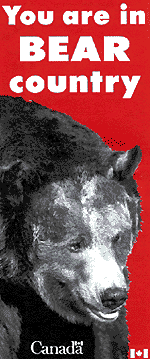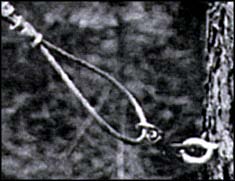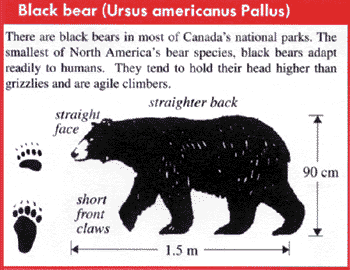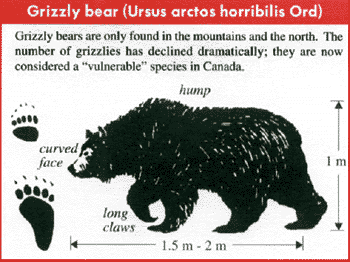

Below please find info that scared the bajesus out of us. We knew there were bear,
but we were not ready for the constant barrage of bear info. We were offered so much of this
information, that soon we were wondering, "Gosh, maybe people are being eaten all
the time and you just never hear about it on the news because that would ruin tourism."
By the time we hit the first real trail, we were quaking in our hiking boots. Along the way we sang every song we knew from old blues standards to some early Dylan. Bad singing keeps the bears away . . . and noise, too. We knocked rocks together and dragged sticks.
What we came to realize is that many people never see a bear, much less come close to one. The thing to do is be prepared, heed the warnings and you'll be fine. You will find it becomes a toss up. You don't want to be too loud that you scare the other animals away, but you want to be loud enough to make sure the bears know you are there.
We actually did see one bear. It was a baby black bear eating berries by the road in Jasper and we watched quietly from the car. Seeing a baby bear alone is bad news because you know the mother can't be far away. They tell you that in the pamphlets. But, of course, a carload of squealing shutterbugs pulled up behind us, crawled out of their vehicle and positioned themselves way too close to that bear. We don't know what happened to those yapping tourists because we drove away, half wishing momma bear would show up.
You are in Bear Country
National parks introduce visitors to a landscape that is uniquely Canadian. But these parks are more than scenic wonderlands. They are home to many animals who depend on undeveloped wild areas for their very survival. For some, like the grizzly bear, national parks are the critical core of a territory that can extend far beyond the parks' boundaries.Bears are Wild Animals
Given the choice, most wild animals will stay clear of visitors. However, like all creatures, including humans, they will defend themselves, their young or their food, if they feel threatened. By understanding why bears behave the way they do and by following a few simple rules, you will increase the chances of safety for you and for the bear.
Store food and garbage properly.Make sure bears know you're there.
These are the two most important steps you can take to reduce the chance of a serious encounter with a bear.
Each bear is unique. Individual circumstances will determine how you deal with a particular bear. This brochure highlights some ways people have steered clear of dangerous situations. For more information talk to park staff. They will provide details about bears in the area you plan to visit and can advise you on appropriate behavior in the backcountry.
Why bears do what they do
Bears have a keen sense of smell: Always on the lookout for food, bears check out anything smelly. If you can smell it, there's a good chance a bear will pick up the scent and come to investigate. Keep yourself and your campsite odor free.
- Avoid smelly foods, try a freeze dried dinner.
- Change clothes you wore while cooking, before going to bed.
- Cook away from your tent, sleeping gear and clothes.
- Save perfumes, hair sprays, and scented soaps for home.
- Wash and put away all dishes and utensils right away.
- In the backcountry, women should keep used tampons in sealed plastic bags.
Bears like human food: Survival in the wild is not easy. Winters are long and cold; food and shelter can be hard to find. It's little wonder animals look on people's food and garbage as an easy meal. Because of this, animals become used to humans, and problems for both visitors and wildlife are the result.
- Always put garbage in bear-proof containers.
- Lock food in the trunk of your car or in the food storage facilities provided at some campgrounds.
- Use airtight containers to store food and garbage.
In the backcountry you need to take special care:
- Cache food away from your tent; you can hang it between two trees, at least 4 m above the ground or use the special facilities where provided.
- Pack out garbage - bears will dig up buried garbage.
Bears don't like surprises: Most bears will leave if they know you're coming.
- Whistle, talk, sing, or carry a noise maker such as a bell or can of stones.
- Be especially careful in dense forest, near rushing water, or traveling into the wind - bears may not be able to hear or smell you.
- Carry a flashlight at night to warn animals of your approach.
- Stay in the open if possible.
- Keep children close to you.
- Watch for bear signs; if you see fresh tracks, diggings, or droppings, choose another area.
- Camp in designated campsites; in the backcountry, pick a spot away from trails and rushing water. Camp near trees you can climb if necessary.
Bears will defend themselves, their cubs and their food:
- Never approach a bear - especially a cub. Mother is usually nearby and will attack.
- Stay away from dead animals and berry patches. Report dead animals to park staff.
Bears don't like dogs: Your pet may come running back to you with a bear in pursuit. In national parks, dogs must be on a leash. It's probably best for you and your dog if you leave your pet at home. Some national parks do not allow dogs at all in the backcountry.
There are black bears in most of Canada's national parks. The smallest of North America's bear species, black bears adapt readily to humans. They tend to hold their head higher than grizzlies and are agile climbers.
Characteristics of the Black Bear:
- Straighter back
- Straight face
- Short front claws
Grizzly bears are only found in the mountains and in the north. The number of grizzlies has declined dramatically; they are now considered a "vulnerable" species in Canada.
Characteristics of the Grizzly Bear:
- Hump back
- Curved face
- Long claws
If you meet a bear Stay calm, talk quietly, don't run- Seeing a bear is exciting; it can also be dangerous, Try to determine what kind of bear it is - black or grizzly. This is not always easy. Even bear specialists have been known to make mistakes. It is important, though, because in the unlikely event of an attack, some techniques work better with certain species.
The three most obvious differences between the two bears are the shape of the face, the back, and the claws. Don't rely on color - grizzlies and black bears can both range from black to blond. Size is also misleading. Female grizzlies can be the same size, or even smaller, than male black bears. While no single method works in every situation, the following suggestions have helped people who found themselves face to face with a bear.
If a bear attacks
Attacks are rare. Most happen when a bear is suprised. Here again, no one method works every time. Your response will depend on the situation and the species of bear. Some people have found the following techniques useful in reducing their chance of injury. Note: Look for signs marked "Caution: bears in area, travel with caution" or "Danger: Area closed due to bear. Do not enter."
If you surprise a bear and it defends itself
These bears will usually leave you alone once they know you're not a threat.
Grizzly
Play dead. Curl up in a ball and cover your face, neck, and abdomen. Remain still until the bear leaves the area. These attacks seldom last more than a few minutes. While fighting back usually increases the intensity of such an attack, in some cases it has caused the bear to leave.
Black bear
are not as aggressive as grizzlies and will usually run away if you surprise them. DO NOT PLAY DEAD! Try to escape or scare the bear away as described below.
If a bear, no matter what the species, stalks or attacks you when you are sleeping
This is more dangerous; these bears are usually looking for food. DO NOT PLAY DEAD. Try to get to a building or car. If you can't, climb a tree, but remember the bear may follow. As a last resort, try to intimidate the bear with a branch or rock.
Bear sprays
These contain a form of cayenne pepper that irritates the bear's eyes and lungs. Wind and other factors may reduce the effectiveness. If the spray blows in your face, you will suffer the same effects as the bear. Despite this, there are reports of these sprays saving lives.
You can help
Grizzly bears once roamed throughout most of western North America. Today they are extinct in Mexico. In the United States they are only found in a few areas in the northwest and in Alaska. In Canada, there are grizzly bears in Alberta, British Columbia, the Yukon and the Northwest Territories. They are considered a "vulnerable" species in much of their range. If they are to survive, we must be careful to protect their habitat and respect their right to live, undisturbed, in the few remaining areas left to them.Unfortunately, bears that become used to people and their food often must be relocated or destroyed because of the threat they pose for visitors. Following the simple steps outlined above can help keep bears away from populated areas and prevent serious incidents. In this way we will help both bears and people to coexist in our national parks.




 For more information about the Canadian Rockies, check out The Mountain
Zone Bookstore. We have a book called The Canadian Rockies Trail Guide.
It's a best selling guide to trails in Banff, Jasper, Kootenay, Yoho, Waterton Lakes, Mount Assiniboine and Mount Robson National and Provincial Parks.
For more information about the Canadian Rockies, check out The Mountain
Zone Bookstore. We have a book called The Canadian Rockies Trail Guide.
It's a best selling guide to trails in Banff, Jasper, Kootenay, Yoho, Waterton Lakes, Mount Assiniboine and Mount Robson National and Provincial Parks.